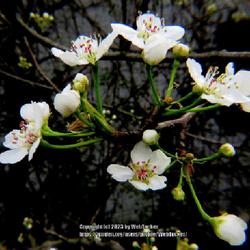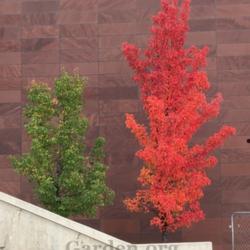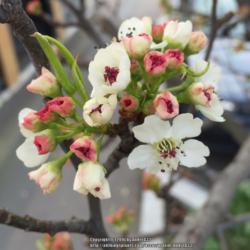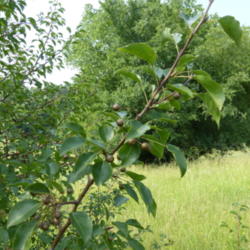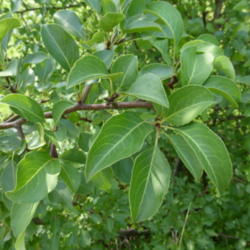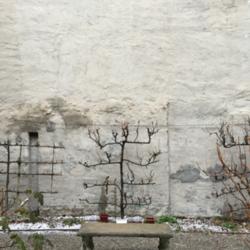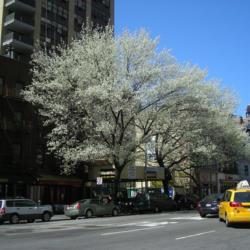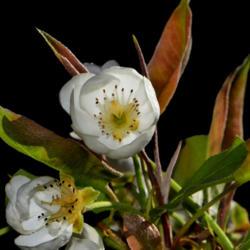General Plant Information (Edit)
| Plant Habit: |
Tree
|
| Life cycle: |
Perennial
|
| Sun Requirements: |
Full Sun
Full Sun to Partial Shade
|
| Water Preferences: |
Mesic
|
| Soil pH Preferences: |
Slightly acid (6.1 – 6.5)
Neutral (6.6 – 7.3)
Slightly alkaline (7.4 – 7.8)
|
| Minimum cold hardiness: |
Zone 5a -28.9 °C (-20 °F) to -26.1 °C (-15 °F)
|
| Maximum recommended zone: |
Zone 9b
|
| Plant Height: |
30 to 50 feet |
| Plant Spread: |
20 to 30 feet |
| Leaves: |
Good fall color
Deciduous
Other: Green, maturing to maroon and deep red in fall.
|
| Fruit: |
Showy
Edible to birds
Other: 1/4 to 1/2 inch inedible pomes are greenish-yellow, maturing to brown.
|
| Fruiting Time: |
Late summer or early fall
|
| Flowers: |
Showy
Malodorous
Blooms on new wood
|
| Flower Color: |
White
|
| Bloom Size: |
Under 1"
|
| Flower Time: |
Spring
|
| Uses: |
Shade Tree
Flowering Tree
Will Naturalize
|
| Wildlife Attractant: |
Birds
|
| Resistances: |
Pollution
Humidity tolerant
Drought tolerant
|
| Pollinators: |
Various insects
|
| Miscellaneous: |
With thorns/spines/prickles/teeth
|
- Accepted: Pyrus calleryana
- Synonym: Pyrus kawakamii
Posted by
Hortaholic (Columbus, Ohio - Zone 6a) on Jan 17, 2024 11:21 PM concerning plant:
Planting Callery pear trees is now banned in several states! The ban in Ohio went into effect in 2023.
The bans apply to all varieties of Callery pear including 'Bradford', 'Cleveland Select', 'Aristocrat' and any other kinds, named or unnamed.
Once considered highly desirable ornamentals, the article below explains how their seeds have been carried by birds into wild areas, where the seedlings have caused ecological havoc.
Please spread the word to anyone who has one of these trees that they would be doing the environment a huge favor by removing it.
Posted by
ILPARW (southeast Pennsylvania - Zone 6b) on Apr 24, 2018 7:28 PM concerning plant:
If Callery Pear did not become so invasive into the wild in eastern North America, I would promote it for parking lot islands and similar tough urban situations. Outside of nice white flowers, it is not a beautiful tree to use in regular landscapes. It is brittle wooded and easily breaks in storms. When it goes wild into nature, it develops horrible sharp branchlets that really hurt and it is really getting aggressive in fields. The first great cultivar of 'Bradford' was a very broad, rounded form that I saw a good number of times break up from storms (I remember seeing one specimen in northeast Illinois breaking right in half), and it was discontinued by the nursery industry by 2000. A number of other cultivars were also discontinued for the same reason. A few more upright, tighter-growing cultivars, such as 'Cleveland Select' and 'Chanticleer,' are still being sold a lot because their breakage is not as severe. This species from China is not very useful for American native beneficial insects, and the fruit is not really good for native birds. I call this "the Chinese Rat Tree."
Posted by
sallyg (central Maryland - Zone 7b) on Nov 25, 2018 8:53 AM concerning plant:
Wild descendants of landscape specimens are now completely filling some highway right of ways here in central Maryland. It readily takes hold when areas are left unmowed.
Posted by
dave (Southlake, Texas - Zone 8a) on Jul 21, 2014 7:18 AM concerning plant:
Introduced into the US in the early 1900s to help with efforts to develop fire blight resistance in the common pear. Callery Pear is invasive in many areas and shouldn't be planted.
Plant Events from our members
| AndreA33 |
On April 27, 2016 |
Plant emerged |
| AndreA33 |
On April 1, 2016 |
Seeds sown |
| WebTucker |
On February 16, 2023 |
Bloomed |
» Post your own event for this plant
« Add a new plant to the database
» Search the Pears Database: by characteristics or by cultivar name
« See the general plant entry for Pears (Pyrus)
« The Pears Database Front Page
« The Plants Database Front Page

